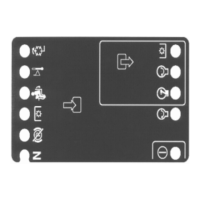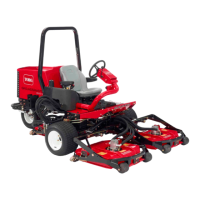h y draulic pump and pushing or to wing the mac hine .
Do not push or to w the mac hine for more than 1/4
mile (0.4 km).
Important: Do not push or to w the machine
f aster than 2-3 MPH (3-4.8 km/h) because inter nal
transmission dama ge may occur . T he bypass v alv e
must be open whenev er the machine is pushed or
to w ed.
Important: If the machine must to be pushed or
to w ed in r ev er se, the check v alv e in the f our -wheel
dri v e manif old must also be bypassed. T o bypass
the check v alv e, connect a hose assembl y (Hose
P ar t No. 95-8843, Coupler Fitting No. 95-0985
[Qty . 2], and Hy draulic Fitting No. 340-77 [Qty . 2])
to the r ev er se traction pr essur e test por t and the
r ev er se f our -wheel dri v e pr essur e por t.
1. Open hood and remo v e the center shroud
2. R otate the b ypass v alv e 90° (1/4 tur n) in either
direction to open and allo w oil to b ypass inter nally
( Figure 15 ). Because fluid is b ypassed, the mac hine
can be slo wly mo v ed without damaging the
transmission. Note the position of the v alv e when
opening or closing .
Figure 15
1. Bypass valve
3. Close the b ypass v alv e before star ting the engine .
Ho w ev er , do not ex ceed 5-8 ft.-lb . (7-11 N·m)
tor que to close the v alv e .
Jacking Points
• On the front of the mac hine on the frame on the
inside of eac h dri v e tire
• On the rear of the mac hine at the center of the axle
Tie Downs
• On eac h side of the frame under the front ste ps
• T he rear bumper
Operating Characteristics
Practice dri ving the mac hine because it has a h y drostatic
transmission and its c haracteristics are different than
many turf maintenance mac hines . Some points to
consider when operating the traction unit, cutting
units , or other implements are the transmission, engine
speed, load on the cutting blades or other implement
components , and the impor tance of the brak es .
T o maintain enough po w er for the traction unit and
implement while operating, regulate the traction pedal
to k ee p the engine RPM high and somewhat constant.
A g ood r ule to follo w is to decrease the g round speed
as the load on the implement increases , and increase
the g round speed as the load decreases .
T herefore , allo w the traction pedal to mo v e bac kw ard
as the engine RPM decreases , and de press the pedal
slo wly as the RPM increases . By comparison, when
dri ving from one w ork area to another , with no load
and cutting unit raised, ha v e the throttle in the F ast
position and de press the traction pedal slo wly but fully
to attain maxim um g round speed.
Another c haracteristic to consider is the operation
of the pedals that are connected to the brak es . T he
brak es can be used to assist in tur ning the mac hine .
Ho w ev er , use them carefully , especially on soft or
w et g rass because the turf ma y be tor n accidentally .
Another benefit of the brak es is to maintain traction.
F or example , in some slope conditions , the uphill wheel
slips and loses traction. If this situation occurs , de press
the uphill tur n pedal g radually and inter mittently until
the uphill wheel stops slipping, thus , increasing traction
on the do wnhill wheel.
Use extra care when operating the mac hine on slopes .
Mak e sure that the seat latc h is properly secured and the
seat belt is buc kled. Dri v e slo wly and a v oid shar p tur ns
on slopes to prev ent roll o v ers . F or steering control,
the cutting unit m ust be lo w ered when g oing do wnhill.
T his pr oduct is designed to dri v e objects into the
g r ound wher e they lose energ y quickl y in g rass
ar eas. Ho w ev er , car eless operation, combined
with ter rain ang le, ricochets, or impr oper l y
positioned safety guard can lead to thr o wn
object injuries.
• W hen a per son or pet appear s suddenl y in or
near the mo wing ar ea, stop mo wing .
• Do not r esume mo wing until the ar ea is
clear ed.
Important: Allo w engine to idle f or 5 min utes
bef or e shutting it of f after a full load operation.
23

